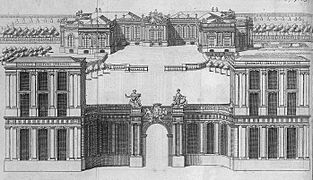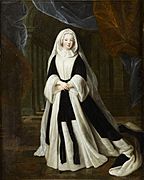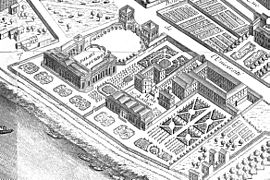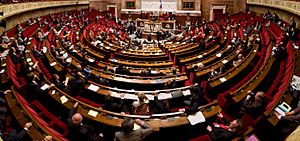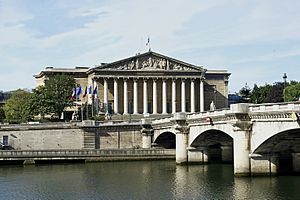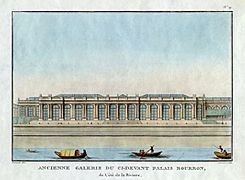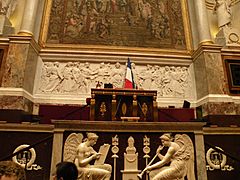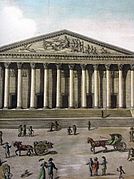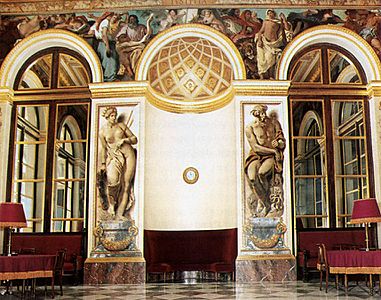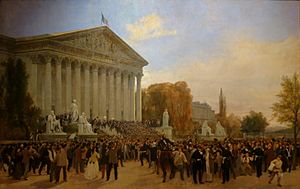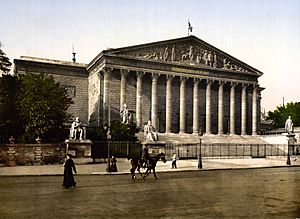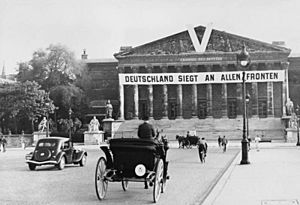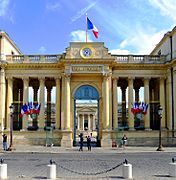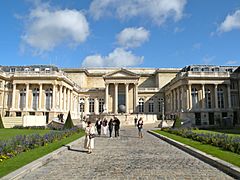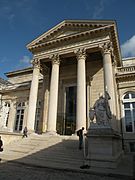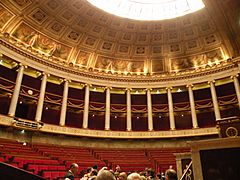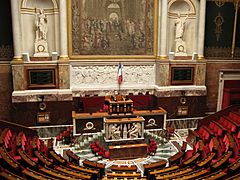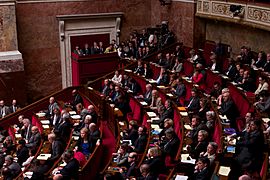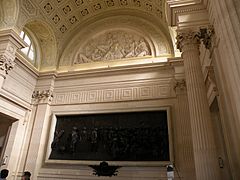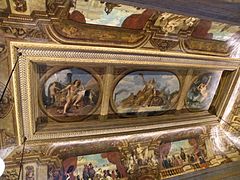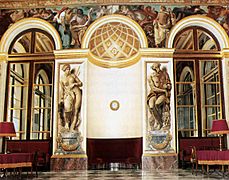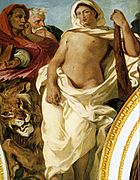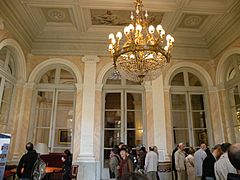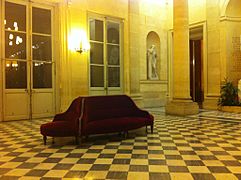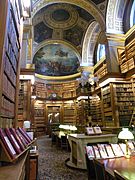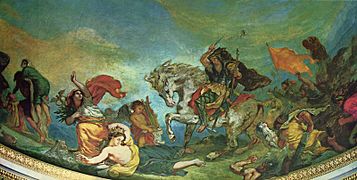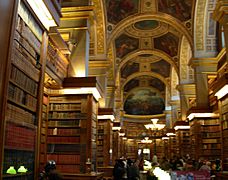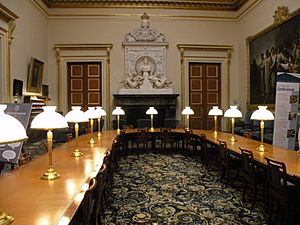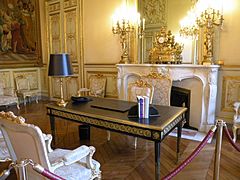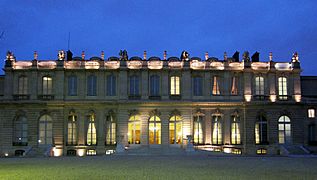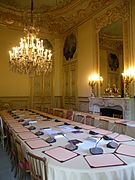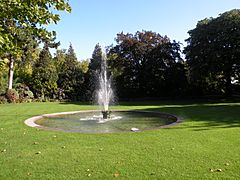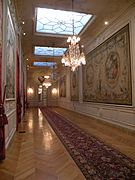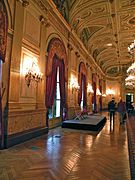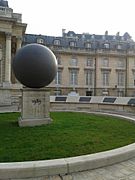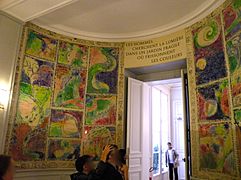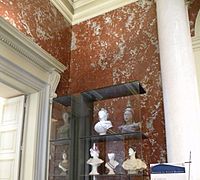Palais Bourbon facts for kids
Quick facts for kids Palais Bourbon |
|
|---|---|

North facade of the Palais Bourbon
|
|
| General information | |
| Location | 7th arrondissement, Paris, France |
| Address | 126 rue de l'Université |
| Current tenants | National Assembly |
| Named for | Louise Françoise de Bourbon |
| Construction started | 1722 |
| Completed | 1728 |
| Renovated | 1765–1788, 1795, 1828 |
| Owner | French State |
| Technical details | |
| Floor area | 124,000 m² |
| Design and construction | |
| Architect | Lorenzo Giardini, Pierre Cailleteau, Jean Aubert and Jacques Gabriel |
| Renovating team | |
| Architect | Bernard Poyet, Jules de Joly |
The Palais Bourbon is a famous building in Paris, France. It is where the National Assembly meets. The National Assembly is like one of the main groups of lawmakers in the French Parliament. The palace is located on the Rive Gauche (Left Bank) of the Seine River. It is right across from the large Place de la Concorde square.
The building was first started in 1722 for Louise Françoise de Bourbon, who was the Duchess of Bourbon. She was a daughter of King Louis XIV. Several architects worked on the palace, and it was finished in 1728. During the French Revolution, the government took over the palace. From 1795 to 1799, it was used by a group called the Council of Five Hundred.
Later, in 1806, during Napoleon's time, a new front was added to the palace. This new front, designed by Bernard Poyet, looked like the Church of the Madeleine across the river. Today, the Palais Bourbon is a huge building with 124,000 m2 (1,330,000 sq ft) of space. It has over 9,500 rooms where about 3,000 people work. The complex also includes the Hôtel de Lassay, which is where the leader of the National Assembly lives.
History of the Palais Bourbon
From Country House to Palace (1726–1789)
The Palais Bourbon was built for Louise Françoise de Bourbon (1673–1743). She was the daughter of King Louis XIV. Construction started in 1722 and finished in 1728. At that time, the area was mostly countryside on the edge of Paris. It soon became a very popular neighborhood for wealthy people.
After King Louis XIV died in 1715, many rich families moved back to Paris from Versailles. They needed new homes with gardens. The old parts of Paris were too crowded. So, they looked for land on the edges of the city, like where the Palais Bourbon was built.
The Duchess of Bourbon was known for enjoying life. She had seven children and was a widow. Her friend, Armand de Madaillan de Lesparre, suggested the location for the palace. He bought land next door along the Seine River. Both buildings, the Palais Bourbon and the Hôtel de Lassay, were built at the same time. The land for the new palace was very large, stretching from the Seine to the rue de l'Université.
The first idea was to build a country home with gardens. It was inspired by the Grand Trianon palace at Versailles. The Italian architect Lorenzo Giardini made the first plans, but he died in 1722. Pierre Cailleteau took over the project. He had worked on Versailles and knew the royal style well, but he also died in 1724. Jean Aubert then continued the work. Meanwhile, the Hôtel de Lassay was being built by another architect, Jacques Gabriel. Both buildings were finished in 1728.
Both the Palais Bourbon and the Hôtel de Lassay were built in an Italian style. Their roofs were hidden from the street. The Palais Bourbon was shaped like a "U". The main part was parallel to the Seine, with two wings around a courtyard. The entrance was on the Rue de la Université. The two buildings had similar fronts facing the Seine. These fronts had columns and windows, with decorations about the seasons and elements. The Duchess's original rooms are gone now because of later changes.
The Duchess of Bourbon died in 1743. The palace was bought by King Louis XV. In 1756, he sold it to the Duchess's grandson, Louis Joseph, Prince of Condé. The Prince was a military hero. He decided to rebuild the palace to make it grander. In 1768, he bought the Hôtel de Lassay next door. He planned to combine the two buildings. A new design was made by Marie-Joseph Peyre, who studied ancient Roman and Greek buildings. The palace was finished in the late 1780s. But then the French Revolution began. The Prince left France, and the government took over both buildings in 1792.
The Revolution and Napoleon's Era (1789–1814)
-
Statue of Jean-Baptiste Colbert, added in 1810
The first French national assembly met in 1789. This was the start of the French Revolution. In 1793, they moved to Paris. Many rich people left France. Buildings like the Palais Bourbon were taken by the government. The Palais Bourbon became a school for public works in 1794. This school later became the famous École Polytechnique.
In 1795, a new government called the French Directory took power. They created a parliament with two groups. One group, the Council of Five Hundred, was given the Palais Bourbon as its meeting place. Architects Jacques-Pierre Gisors and Emmanuel-Cherubin Leconte changed the palace rooms into a meeting hall. It was shaped like a half-circle, similar to a Roman theater. The first meeting was on January 21, 1798. But the sound in the room was not good.
Two parts of this first meeting room are still in the new one today. These are the desk and chair for the President of the Assembly. They were designed by Jacques-Louis David. Also, there is a stone carving behind the speaker's platform. It shows two women representing History and Fame. History writes down laws, and Fame announces them. In the middle is a statue of Marianne, a symbol of France.
The new meeting room changed the building a lot. The roof had to be raised. Also, the building was not perfectly lined up with the Place de la Concorde and the bridge.
The Council of Five Hundred started meeting on January 21, 1798. Members wore Roman-style clothes. They found the room had poor air circulation and was hard to heat. The sound was also bad. But this did not matter for long. On November 8, 1799, Napoleon Bonaparte took control of the government. He created a new law-making group called the Corps Legislatif. This group had little power.
Napoleon wanted the building to look grand. In 1806, a new front was added facing the Seine River. It was designed by architect Bernard Poyet. This new front had twelve tall columns. It was built to match the Church of the Madeleine across the river. The original carving on the front showed Napoleon on horseback. It said, "To Napoleon I the Great – the Corps Legislatif." In 1810, statues of the goddesses Themis and Athena were placed in front. Statues of famous French ministers were also added. Poyet also added two new rooms inside for Napoleon. These rooms still have their original paintings by Alexandre-Évariste Fragonard.
Restoration and Monarchy (1814–1848)
-
The Salon of the King, decorated by Eugène Delacroix (1833–38)
-
The library, with paintings by Eugène Delacroix (1838–1846)
After Napoleon's fall in 1814, the Bourbon monarchy returned. The Palais Bourbon was given back to its owner, the Prince of Condé. But the building was too changed to live in. So, the Prince rented a large part of it to the new Chamber of Deputies. In July 1815, all signs of Napoleon, like his name and eagles, were removed from the building. The carving on the front was replaced with one of Louis XVIII. The Chamber of Deputies rented the building until 1827, when they finally bought it.
The meeting hall was in bad shape. So, the Chamber decided to renovate it. The architect Jules de Joly was chosen. He had been the official architect since 1821. The Chamber decided to keep the half-circle shape for the meeting room. De Joly also redesigned three rooms facing the main courtyard. Work began in 1829. Over three hundred workers were involved. The work continued even after the Revolution of 1830. This revolution brought a new king, Louis Philippe. The new interior was finished in 1832.
The meeting hall kept its half-circle shape. But the floor was lowered, making the ceiling higher. A colonnade (row of columns) and balconies were added behind the speaker's platform. This made it look like a theater stage. A large painting of Louis-Philippe taking his oath was placed there. Statues of "Liberty" and "Public Order" were also added.
Joly's plan also changed the main entrance. Under Napoleon, the main entrance was on the Seine side. Now, the main entrance was on the courtyard side. Joly built a new entrance with four columns there. This made the building much larger inside. It added three new rooms. Now, people could move between different parts of the building without going outside or through the main meeting room.
In 1837, new decorations were added to the outside. The old carvings from Napoleon's time were replaced. New art was added, like "France supported by Force and Justice" by Corton. For the new entrance on the courtyard, two statues called "France" and "Liberty" were planned. These were installed later, in 1860.
Adolphe Thiers, a future President of France, oversaw the inside decoration. He chose a young painter, Eugène Delacroix, to paint murals. Delacroix created paintings of Justice, Truth, Prudence, War, Industry, and Agriculture. These murals are still in the Salon Delacroix today. Another room, the Salle des Pas-Perdus, was decorated by Horace Vernet. His paintings showed peace in Europe and the growth of trade and industry. A third room was painted by Abel de Pujol, showing scenes from French history.
A new library was also built on the east side of the palace. It was designed like ancient Roman baths. It had pillars supporting five domes, which let in light from above. Eugène Delacroix painted the inside of the library from 1838 to 1846. He painted allegorical scenes about philosophy, history, laws, and literature.
The Chamber of Deputies still needed more space. They bought the west wing of the palace in 1830 and the Hôtel de Lassay in 1843. Joly was again chosen to redesign the Hôtel de Lassay. He added another floor and tried to bring back its original 18th-century style. The work was almost done when the 1848 French Revolution happened. The King left, and the Chamber of Deputies was closed. This led to the French Second Republic.
Second Republic and Second Empire (1848–1870)
After the Revolution in February 1848, France had a difficult time. The large painting of Louis Philippe was removed from the meeting room. It was replaced by a tapestry called The School of Athens. A new election chose a Constituent Assembly. The French Second Republic was announced at the Palais Bourbon on May 4. Later, a crowd invaded the room, asking for a more radical government.
A new National Assembly was elected. Louis Napoleon Bonaparte, Napoleon's nephew, became president. In December 1851, he took power and became Emperor Napoleon III. This ended the Second Republic. Lawmakers who opposed him were arrested. The Assembly still met in the Palais Bourbon, but they had little power. They could not speak from the main platform.
After 1860, the Emperor gave the lawmakers more freedom. Debates started again in the Palais Bourbon. In 1870, the Assembly voted for war with Prussia. But the French army was quickly defeated. The Emperor was captured. On September 2–3, the French Third Republic was formed.
The Third Republic (1871–1940)
After the defeat, a temporary government was formed. Paris was surrounded by German soldiers. The Palais Bourbon was left empty. The Assembly moved to Bordeaux, then to Versailles. In March 1871, the Paris Commune took control of the city. But in May, the French Army stopped them. The Palais Bourbon was saved from being destroyed. Other government buildings were burned. The Assembly stayed in Versailles until 1879.
The new Assembly of the Third Republic was much larger. It had 531 lawmakers. The President of the Chamber, Léon Gambetta, wanted to make the meeting space bigger. Many plans were considered, but none were approved.
During the Third Republic, the Palais Bourbon was the main place for the French government. The Assembly chose the President of France. It also controlled money and foreign policy. Lawmakers sat on the right or left side of the room, depending on their political views. Many important debates happened here. Sometimes there was trouble. In 1898, a lawmaker was hit during a speech. In 1890, a bomb exploded in the gallery. The Assembly declared war in 1914 and celebrated victory in 1918. But in the 1930s, it struggled with economic problems and the approach of World War II.
World War II and Later Republics
In June 1940, the German army came to Paris. The government and Assembly left Paris. They moved to Vichy. The Germans used the Palais Bourbon as a military court. It also had offices for sending French workers to Germany. German banners were put on the front of the palace. During the liberation of Paris in August 1944, parts of the palace were damaged. A fire in the library destroyed many books. Philippe de Gaulle, son of Charles de Gaulle, helped negotiate the surrender of German troops at the Palais Bourbon.
The Fourth French Republic started in 1946. New technology, like microphones, came to the Palais Bourbon. But the government had many political parties, and it was often unstable. The Algerian Crisis in 1956 ended the Fourth Republic. A new Constitution was approved, starting the Fifth French Republic, which is still in place today.
The Palais Bourbon Today
The Court of Honor
The Court of Honor is south of the Palais. It has been the main entrance since the palace was built. It was changed in the 1830s with a ceremonial entrance. The statues on either side of the entrance represent Universal Suffrage and the Law. They were added in 1860. In the middle of the courtyard is a granite ball called the Sphere of Human Rights. It was added in 1989 to celebrate 200 years of the French Revolution. It was made by American sculptor Walter De Maria.
Meeting Chamber
The salle des Séances, or meeting chamber, looks much like it did in 1832. The Assembly meets for nine months each year, from October to June. The 577 lawmakers are elected for five years. They sit in a half-circle. Lawmakers from left-leaning parties sit on the left. Those from more conservative parties sit on the right. The President of the Assembly sits high up against the wall. This shows that the President is also a lawmaker. The President's chair was designed by Jacques-Louis David.
Lawmakers vote by pushing a button. The results are shown on a screen. The meetings are open to the public, but you need to ask a lawmaker's office for access. The meetings are also shown live on the Assembly's website.
Salons (Reception Rooms)
The salons (large reception rooms) of the Palais Bourbon were created during the time of Louis-Philippe. They were decorated by famous artists like Eugène Delacroix.
- The Salle Casimir-Périer is a wide hallway with a curved ceiling. It connects the meeting chamber to other rooms and the main courtyard. It has a huge bronze carving by Jules Dalou. This carving shows the first meetings of the Assembly during the French Revolution. It is very long and heavy. The hall also has six statues of important Assembly members. These statues represent different ideas, like resisting unfair governments or popular uprisings. This hall is where government members gather before answering questions from lawmakers.
- The Salon Delacroix was decorated by Delacroix when he was only 25. It was first called the Salon de Roi. It was a place for King Louis-Philippe to meet lawmakers. The work was finished in 1836. The main decorations are four figures that represent "the living forces of the State": Justice, Agriculture, Industry, and War. Two paintings on the west wall show the Ocean and the Mediterranean. This room is now used by left-leaning lawmakers for informal talks.
- The Salle des Pas-Perdus was once a bedroom in the Duchess's home. It became a formal hall under Louis-Philippe. It was decorated with paintings by Horace Vernet and Charles Séchan in 1839. Vernet's main painting is Peace distributes her benefits. It is flanked by paintings about steam power, showing a train and a steamship. The President of the Assembly walks through this room on the way to meetings. Drums play, and guards salute as the President passes.
- The Salon Abel de Pujol was created and decorated in 1838–1840. It is named after the artist Abel de Pujol. He painted scenes on the ceiling showing French rulers who helped create laws. These include Clovis I, Charlemagne, Louis IX, and Louis-Philippe. Today, this room is used by right-leaning lawmakers for discussions during Assembly sessions.
- The Salon des quatre colonnes has several sculptures. These include statues of ancient lawmakers like Brutus and Solomon. Near the door to the Assembly Chamber are busts of two famous lawmakers: Albert de Mun (right) and Jean Jaurès (left). A marble monument lists lawmakers who died in World War I. A statue of the Republic remembers those who died in World War II. This room is now used for TV interviews with lawmakers.
Library
-
Delacroix's image of Attila attacking western civilization
-
Hesiod and the Muse, representing poetry and science
The Library was built starting in 1830. It was designed by architect Jules de Joly. It looks like ancient Roman baths. Pillars support five domes that let in light. The decoration was done by Eugène Delacroix and his team from 1838 to 1847. The paintings on the ceiling show different types of knowledge: poetry, religion, laws, philosophy, and science. The stories come from ancient times. They show great thinkers and dangers to democracy. Large paintings at each end show Orpheus bringing the benefits of arts and civilization and Attila and his barbarian hordes.
The library's first collection came from books taken from churches and rich families during the Revolution. It also has rare items donated to the Assembly. These include the trial records of Joan of Arc and writings by Jean-Jacques Rousseau. It also has the Codex Borbonicus, an ancient Aztec book. The library is only for lawmakers and their staff. It is not open to the public.
Salle des conférences and Deputies Buffet
The Salle des Conférences is a large room with tables. Lawmakers can read, talk, and check messages here. It was once the dining room of the Prince de Condé. It was changed in 1830. The ceiling has paintings by Heim about the history of kings and parliaments. There are also large paintings by the fireplace. These show historical events related to government.
Next to this room is the Deputies Buffet. It was created in 1994 and updated in 1997. It is only for current and former lawmakers.
Hôtel de Lassay
The Hôtel de Lassay is next to the Palais Bourbon. A hallway connects them. This building is the official home of the President of the National Assembly. It was rebuilt in 1846–48, with an extra floor. But its 18th-century style was kept.
The Cabinet du Départ is where the President leaves from when a bell rings for the Assembly session. This room is very fancy. It has a carpet from the time of Louis XIV. It also has a tapestry that looks like the painting The School of Athens. This room was the original study before the Revolution. The desk in the room came from the Chateau of Versailles in 1794.
The Salon des Jeux is a meeting room on the ground floor. The President meets with other leaders here to plan the Assembly's schedule. Its name comes from a painting over the door showing a game of lawn bowling.
The Salle des fêtes and the Galerie des tapisseries are in the building that connects the Hôtel de Lassay and the Palais Bourbon. The Salle des fêtes was built between 1846 and 1849. It is used for exhibitions, ceremonies, and New Year greetings. The Galerie des tapisseries was made in 1860 to show paintings. In 1900, nine Beauvais tapestries replaced the paintings.
Contemporary Art
The Palais Bourbon has several modern art pieces. One is a large granite sphere by American sculptor Walter De Maria. It was put in the Courtyard of Honor in 1989. This was to mark the 200th anniversary of the French Revolution. The granite sphere has a small gold heart inside.
A work by Belgian artist Pierre Alechinsky was created in 1992. It is in a small round room connecting the Hôtel de Lassay and the Palais Bourbon. It is called "The Fragile Garden." It shows the words of poet Jean Tardieu: "Men search for the light in a fragile garden where the colors tremble."
The Salon of Marianne, created in 2004, shows statues of Marianne. She is a symbol of France. Since 2015, it has a work by American graffiti artist JonOne. It is called Liberté, Egalité, Fraternité (Liberty, Equality, Fraternity). It is based on Delacroix's famous painting Liberty Leading the People. It represents Youth, the Future, and Hope.
Other modern artworks in the Palais Bourbon are by Hervé Di Rosa, Djamel Tatah, Vincent Barré, and Fabienne Verdier.
See also
 In Spanish: Palacio Borbón para niños
In Spanish: Palacio Borbón para niños
- Luxembourg Palace, where the French Senate meets
- National Assembly (France)
- List of works by James Pradier Sculpture



